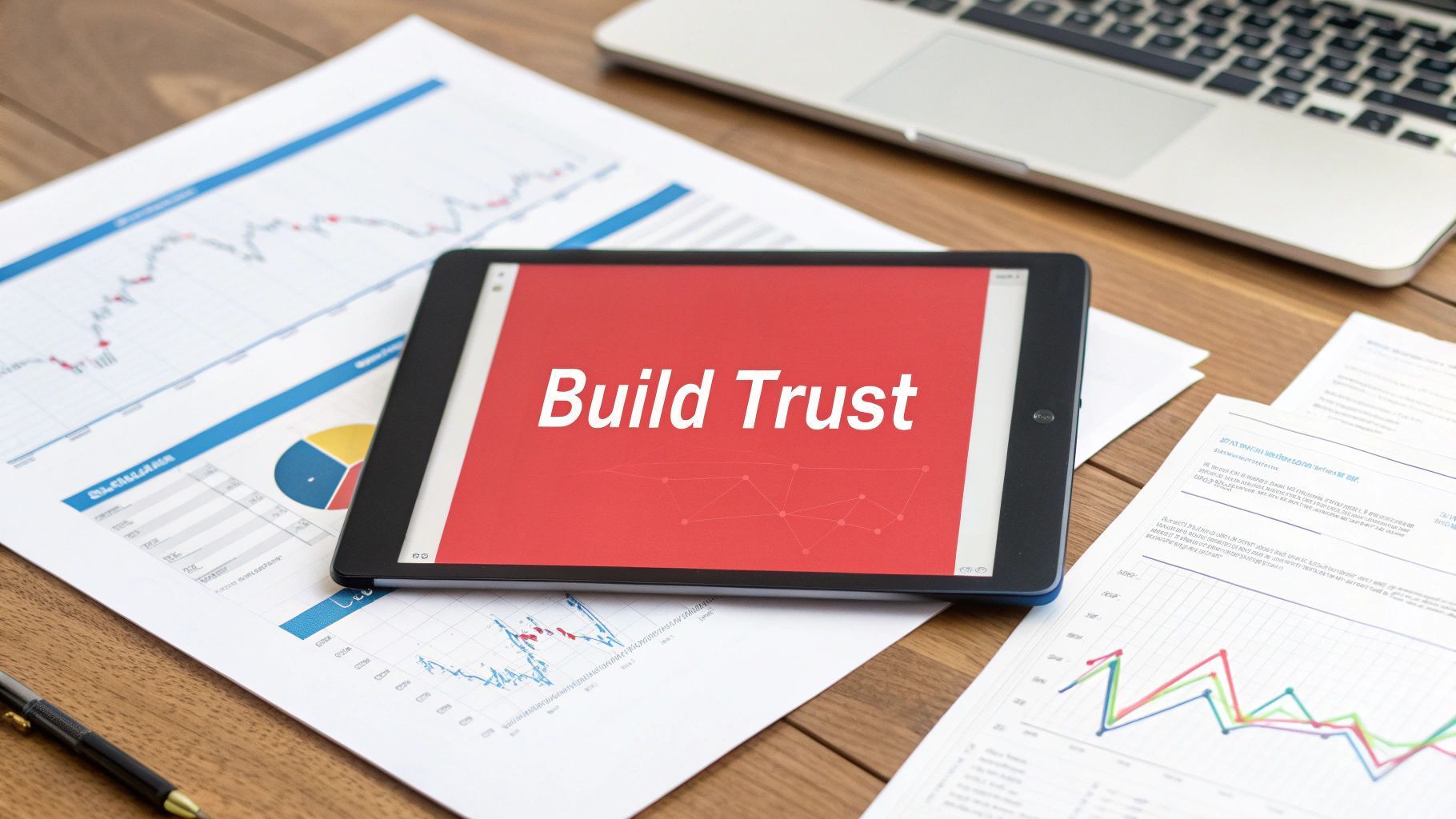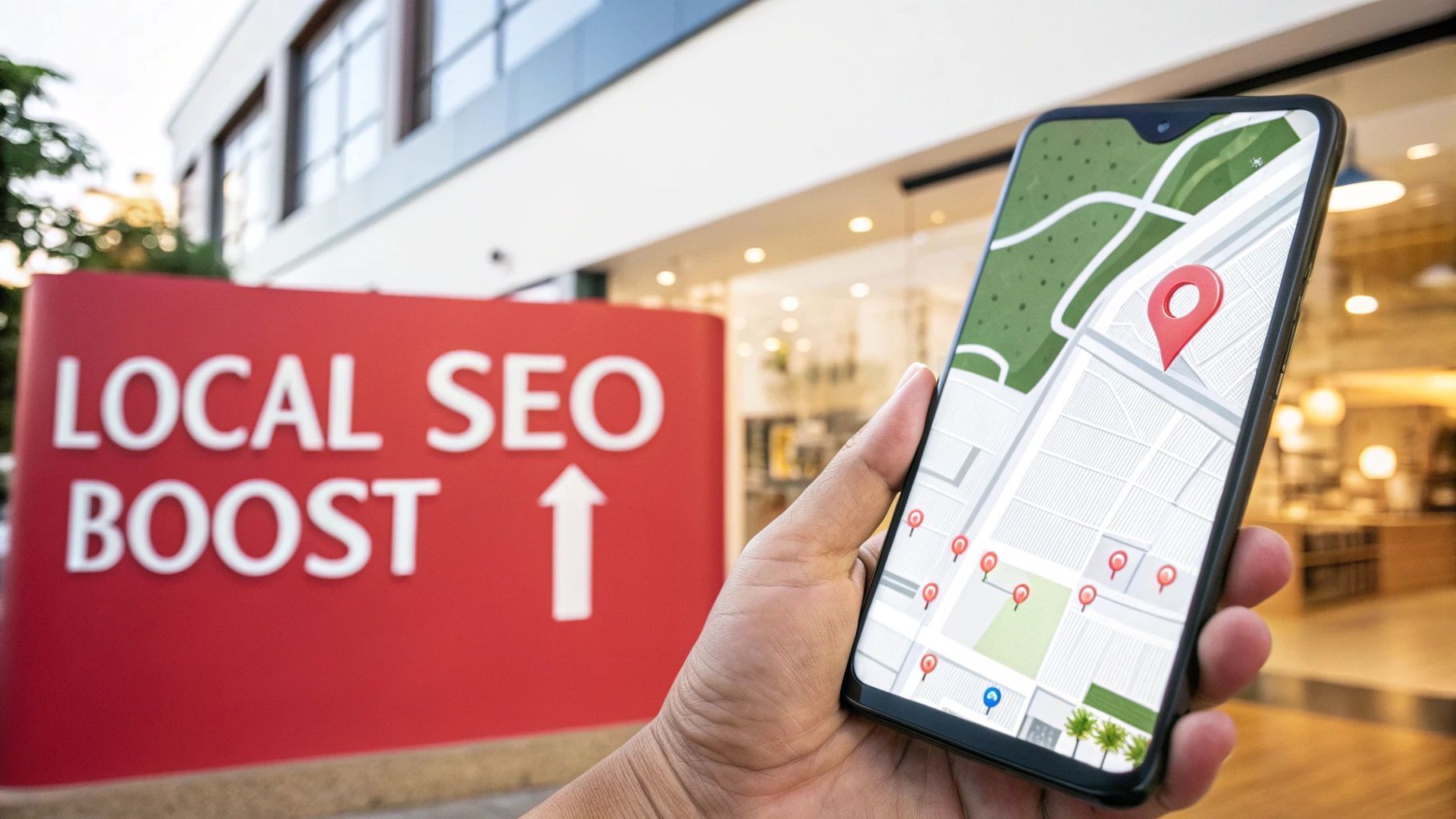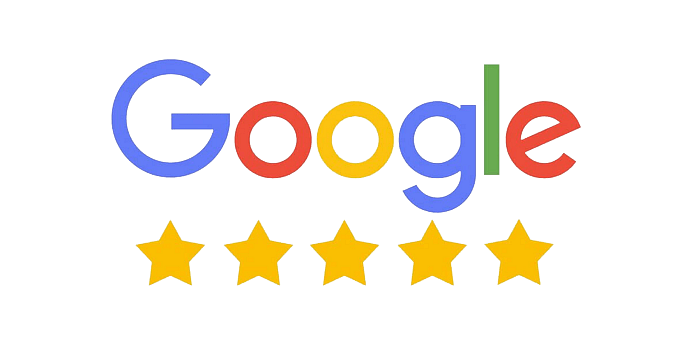Social Media Management for Small Businesses Guide
For a small business, social media management is about much more than just posting updates. It’s about creating a clear plan that turns followers into actual customers by defining who you’re talking to, picking the right platforms and creating content that hits specific goals like bringing in leads or driving sales.
Building Your Social Media Foundation
Jumping onto social media without a strategy is like setting off on a road trip without a map. You might end up somewhere but it almost certainly won't be where you intended to go. Real success starts with a solid foundation, built on clear goals and a deep understanding of your audience.
Forget vague ambitions like ‘getting more followers’. While a growing audience is nice, it’s just a vanity metric unless it actually helps your business. Instead, you need to focus on specific, measurable objectives.
Set Meaningful Business Objectives
What do you actually want social media to do for your business? The goals you set will shape every single decision that follows, from the platforms you choose to the content you post.
Here are a few practical objectives to think about:
- Increase website traffic by driving clicks from your posts to your blog or product pages.
- Generate qualified leads by offering something valuable, like a free consultation or a downloadable guide.
- Boost direct sales through platforms with built-in e-commerce features, such as Instagram Shopping.
- Build brand awareness within a specific local area or a niche industry.
A common mistake is trying to be everywhere at once. A small business with a focused strategy on one or two platforms will always outperform one that spreads itself too thinly across five.
Identify Your Target Audience
Once you know what you want to achieve, you need to know who you’re trying to reach. Creating a detailed customer persona is a vital step here. Go beyond basic demographics and really dig into their interests, online habits and the problems they’re trying to solve.
Ask yourself questions like:
- Where in the UK do they live?
- What are their hobbies and interests?
- Which social media platforms do they actually spend their time on?
- What kind of content do they stop scrolling for?
This insight is crucial. For example, a local plumbing service in Devon would be smart to target homeowners in their area on Facebook. In contrast, a UK-wide B2B software company would find far more success connecting with professionals on LinkedIn. You can explore our guide for more detail on the essential steps to social media success.
For any small business owner, mastering social media for small business success is a non-negotiable. The challenge is real; over 70% of UK small businesses admit they aren't fully using social media. That’s a massive missed opportunity, especially when you realise that 4.9 billion people use social platforms every single day.
Choosing the Right Social Media Platforms for Your UK Business
Picking the right platform is all about going where your audience already is. Trying to force a connection on a network they don't use is a waste of time and energy. This table breaks down the main players in the UK to help you make a smarter choice.
| Platform | Primary UK Audience | Best For | Content Format |
|---|---|---|---|
| Wide range, strong in 30+ age group, community focus. | Local businesses, community building, customer service, targeted ads. | Images, videos, text updates, live streams, events. | |
| 18-35 year olds, visually-driven audience. | E-commerce, lifestyle brands, visual storytelling, influencer marketing. | High-quality photos, Reels, Stories, carousels. | |
| Professionals, B2B decision-makers, corporate audience. | B2B lead generation, industry networking, thought leadership. | Articles, professional insights, company updates, text posts. | |
| TikTok | Primarily Gen Z & Millennials (16-30). | Trend-led content, user-generated campaigns, brand personality. | Short-form vertical videos with music and effects. |
| X (Twitter) | News junkies, professionals, tech-savvy users. | Real-time updates, customer service, breaking news, public conversation. | Short text posts (tweets), polls, threads, videos. |
| Predominantly female, focused on inspiration & planning. | Retail, home décor, food, fashion, DIY, driving website traffic. | Visually appealing images (Pins) and short videos. |
Ultimately, your customer persona should be your guide. A local bakery would thrive on Instagram and Facebook, while a financial consultant would build credibility on LinkedIn. Don't feel pressured to be everywhere—master one or two platforms first.
This decision tree infographic helps visualise how your audience and business type can guide your choice of platform.
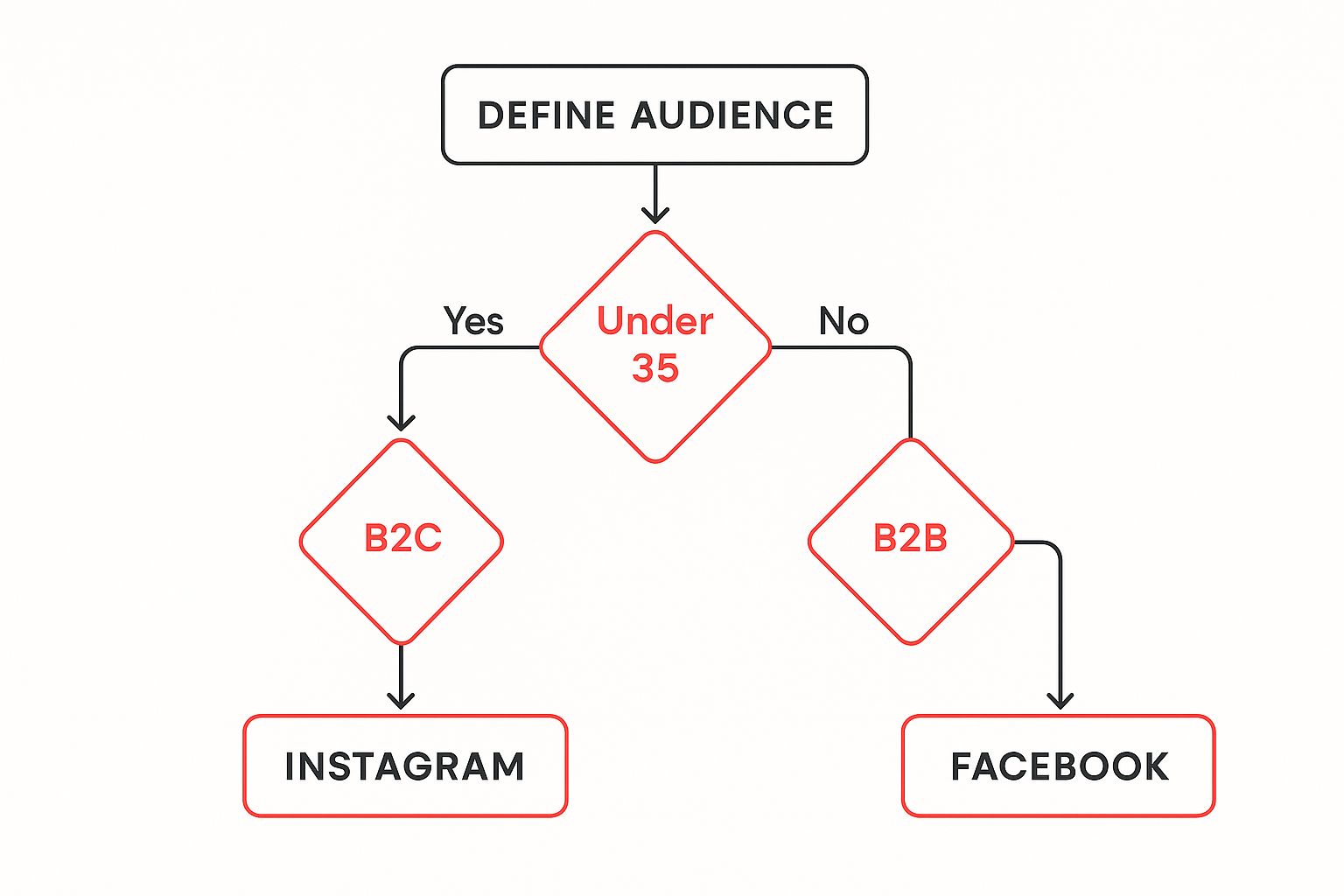
The infographic shows a clear path. It suggests B2C businesses targeting younger audiences should prioritise Instagram, while B2B companies will find their footing on LinkedIn. Getting this foundational work right ensures your efforts are targeted and efficient from the very beginning.
Crafting Content That Actually Connects
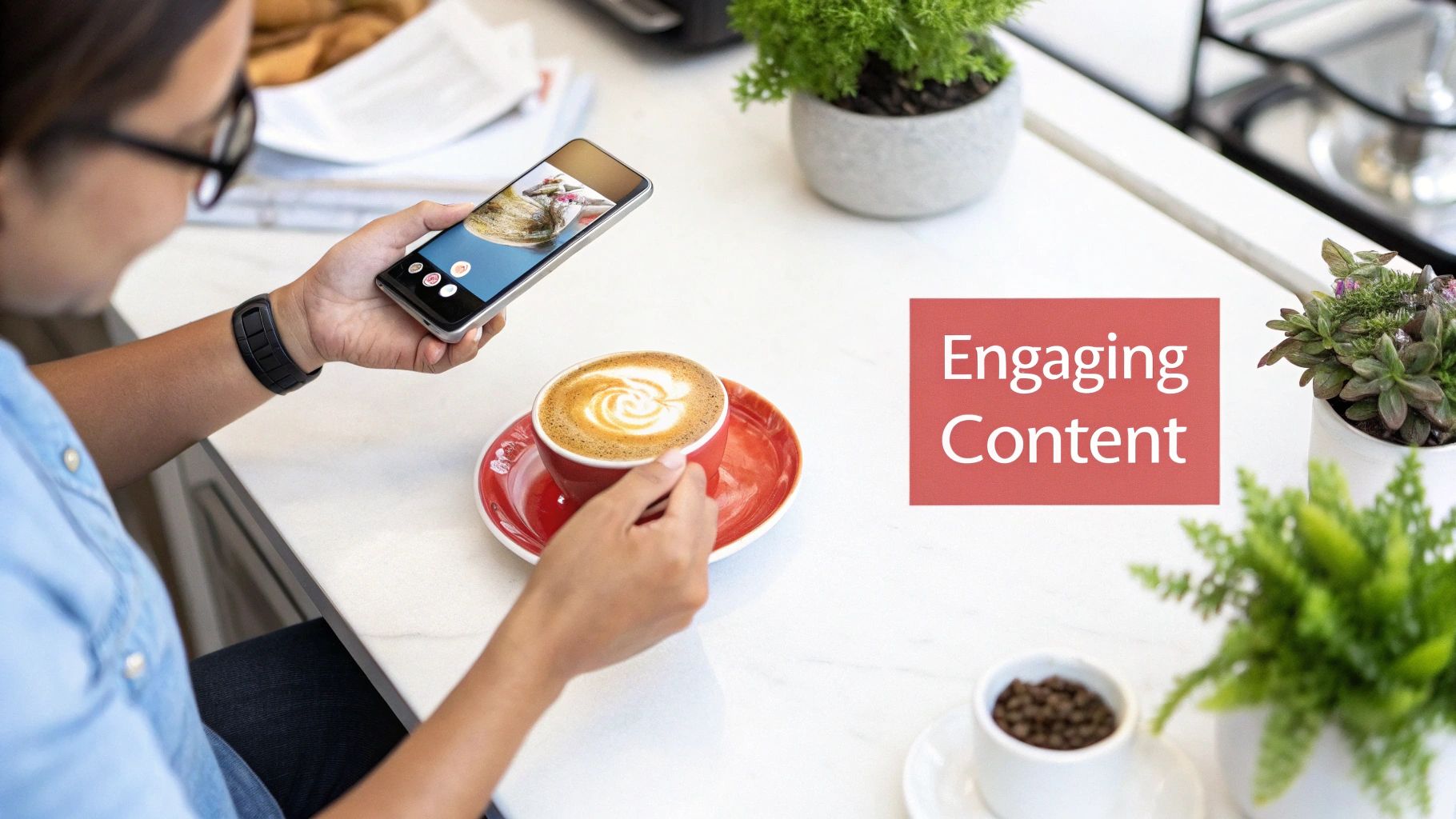
Once you have a solid strategy, the real work begins: creating content that actually stops the scroll and gets people to listen. Effective social media isn't about shouting into the void with constant sales messages. It’s about building a genuine relationship through a thoughtful mix of valuable, entertaining and promotional updates.
Getting that balance right is everything. If your feed is just one sales pitch after another, you’ll bore your audience into unfollowing you. A good rule of thumb is to make the vast majority of your posts about educating, entertaining or inspiring your followers, with only a small slice dedicated to directly promoting what you sell.
Develop Your Content Pillars
To avoid that dreaded feeling of staring at a blank calendar, you need to establish your content pillars . Think of these as three to five core themes or topics that your brand will consistently own. They act as your North Star, ensuring everything you post is relevant to your business and interesting to your audience.
Let's imagine a local Devon-based coffee shop. Their content pillars might look something like this:
- Our Coffee: Showcasing the beans, unique brewing methods and the story behind their signature drinks.
- Behind the Scenes: Introducing the baristas, sharing a 'day in the life' of the shop or showing how the pastries are made fresh each morning.
- Community Spirit: Highlighting local events, featuring loyal customers (with their permission, of course!) or partnering with other nearby businesses.
- Coffee Education: Sharing tips for brewing the perfect cup at home, explaining different roast profiles or exploring the origins of a particular bean.
These pillars become an endless well of ideas, keeping your feed fresh and varied while constantly reinforcing what your brand is all about.
Remember, the goal isn't just to be seen, it's to be remembered. Consistency in your themes, voice and visual style is what builds the recognition that turns a casual follower into a loyal customer.
Master the Art of Captivating Content
You don’t need a professional studio or a massive budget to create content that connects. Your smartphone is more than powerful enough and in today's world, authenticity almost always outperforms polished, corporate-style visuals.
Focus on creating content that feels real and provides genuine value. This could be a quick video tip, a behind-the-scenes glimpse or a beautifully shot photo of your product in action. If you want to go deeper on this, we've got a whole guide on the power of creating content that converts that you'll find useful.
Of course, the visual is only half the story. Writing compelling captions is just as important. A great caption does more than just describe the image; it adds context, personality and a reason for your audience to engage.
- Ask questions: Get the conversation started by asking for your followers' opinions or experiences.
- Tell a story: Share the narrative behind the product, a customer success story or a funny anecdote from the office.
- Use a clear call-to-action (CTA): Tell people exactly what you want them to do next, whether that’s to "visit our website", "tag a friend" or "share your thoughts below."
Maintain a Consistent Brand Voice and Style
Your brand voice is the distinct personality your business shows the world. Are you friendly and informal? Professional and authoritative? Witty and fun? Defining this voice and sticking to it helps your audience feel like they actually know you.
The same goes for your visual style. A consistent look makes your brand instantly recognisable. This means using a specific colour palette, a couple of core fonts and a consistent style of photography or graphic design. When someone is scrolling through their busy feed, they should know a post is yours before they even see your name.
This consistency builds trust. It signals professionalism and reliability, which are crucial factors when a potential customer is deciding whether or not to do business with you. It’s a quiet but powerful part of social media that leaves a lasting impression.
Building a Community, Not Just a Following

So many businesses get this wrong. They treat social media like a megaphone, just broadcasting their message without ever stopping to listen. This approach misses the entire point. Good social media management for small businesses isn't about collecting followers; it’s about cultivating a genuine, engaged community that actually cares about your brand.
A community is built on conversation. It's about transforming your social media profile from a digital billboard into a welcoming space where customers can connect—both with you and with each other. This is how you turn passive scrollers into your most loyal brand advocates.
The Art of Active Engagement
Responding to comments and direct messages is the bare minimum. Ignoring your audience is the quickest way to make them feel invisible and undervalued. You should aim to reply to every genuine comment, even if it's just a quick "thank you".
But real engagement is proactive. Don't just sit back and wait for people to talk to you; start the conversations yourself. Ask open-ended questions in your captions, run polls in your Stories and actively seek opinions. It sends a clear signal that you see your audience as people, not just numbers on a screen.
Here are a few simple ways to get the ball rolling:
- Ask for advice: A local boutique could post two new dress designs and ask, "Which one should we stock for summer? Let us know your favourite in the comments!"
- Run a simple poll: A Devon-based café could ask followers, "Flat white or a latte to start the week? Vote in our poll!"
- Share a relatable struggle: A business consultant might post, "What's the biggest challenge you're facing with your marketing this month?"
Handling Feedback Gracefully
Your community won't always be full of praise and that’s perfectly fine. How you handle negative feedback in public says more about your brand than a hundred five-star reviews ever could. The key is to respond calmly, professionally and with a real desire to help.
Never, ever delete negative comments unless they are offensive or pure spam. Instead, acknowledge the issue publicly and then offer to move the conversation to a private message to sort it out. This shows transparency and proves to other customers that you take their concerns seriously. It can turn a potential crisis into a masterclass in customer service.
A prompt and empathetic response to a complaint can often turn an unhappy customer into one of your most loyal advocates. They will remember how you made them feel, not just the problem they had.
Encourage User-Generated Content
User-Generated Content (UGC) is one of the most powerful tools in your community-building arsenal. It’s authentic social proof that comes directly from your happy customers. The best way to get it is to encourage your followers to share photos or videos of themselves using your products, perhaps by creating a unique brand hashtag.
For instance, a local garden centre could run a competition asking customers to share photos of their gardens using the hashtag #DevonBlooms. You can then feature the best entries on your own feed. Not only does this give you brilliant, authentic content for free but it also makes your customers feel seen and valued. This directly strengthens https://www.superhub.biz/the-role-of-social-media-in-building-brand-loyalty by making your customers a real part of your brand's story.
This kind of active engagement is especially critical in the UK. With around 79% of the UK population —roughly 54.8 million people —using social media, the opportunity for small businesses is enormous. While younger adults aged 18-24 are the most active, older demographics are also there in huge numbers. Your community is out there, waiting to be built.
By focusing on conversation, showing you care and celebrating your customers, you build far more than a following. You create a thriving community that will support and champion your business for years to come.
Streamlining Your Social media Workflow

Consistency is the engine of social media growth. But for a small business owner, it often feels like a second full-time job. The secret isn't to work harder; it's to work smarter. A streamlined workflow can transform social media from a relentless daily chore into a manageable, strategic part of your business.
This is about moving away from panicked, last-minute posting and building a system that keeps you active and engaged online—without being glued to your screen 24/7. The goal is a process that claws back hours every week, freeing you up to focus on what you do best: running your business.
Plan Ahead With a Content Calendar
A content calendar is your single most important tool for efficient social media management for small businesses . The concept is simple: a plan of what you’ll post and when, laid out weeks or even months in advance. This proactive approach stops the daily scramble for ideas and keeps your content consistently aligned with your goals.
Your calendar doesn't need to be fancy. A simple spreadsheet, a Trello board or a dedicated planner all work brilliantly. The real magic is in batching your work. Instead of trying to think of, create and post something new every single day, you set aside a few hours once a week or month to get it all done at once.
This way of working delivers huge benefits:
- It builds consistency: Your audience knows when to expect content, which builds anticipation and loyalty.
- It saves mental energy: Planning ahead frees up daily headspace, killing the stress of "what on earth do I post today?"
- It gives you a strategic overview: You can see your marketing messages at a glance, ensuring you have a healthy mix of promotional, educational and entertaining content.
Planning your social media in batches is like meal prepping for the week. It takes a bit of effort upfront but it saves you time and stress every single day, ensuring you always have something good ready to go.
Leverage Social Media Scheduling Tools
Once your content is planned, scheduling tools are the next step to reclaiming your time. These platforms let you upload everything at once and schedule it to publish automatically at the best times for your audience. Instead of logging into Instagram, Facebook and LinkedIn every day, you let the software do the heavy lifting.
Many of these tools are designed specifically for small businesses, offering affordable plans packed with powerful features. This isn’t just about posting; it’s about creating a fully automated system that works for you in the background.
Think of a local restaurant. The owner could spend a Monday morning scheduling the entire week's content: a "Meet the Chef" feature for Tuesday, a promotion for their Wednesday steak night, a customer photo feature for Friday and a preview of the Sunday roast. The posts go out like clockwork, keeping the restaurant's social feeds active while the owner focuses on running the service.
Popular Social Media Management Tools for Small Businesses
Choosing the right tool really comes down to your budget, your team size and the platforms you use most. To help you get started, here’s a quick comparison of some popular, cost-effective options that are a great fit for small businesses.
| Tool | Key Feature | Best For | Starting Price (Approx.) |
|---|---|---|---|
| Buffer | Straightforward scheduling & a simple interface. | Beginners and solo business owners looking for no-fuss scheduling. | Free plan available; from £5/month per channel. |
| Sendible | An affordable all-in-one platform with reporting features. | Small businesses wanting scheduling, engagement and analytics in one place. | From £25/month. |
| Vista Social | Robust team features at an affordable price point. | Small teams that need to collaborate on content and approvals. | From £30/month. |
| Later | Highly visual planner with a focus on Instagram. | E-commerce and lifestyle brands that rely heavily on visual platforms. | From £15/month. |
When you combine a content calendar with a scheduling tool, you create a seriously powerful system. This streamlined workflow ensures your social media presence stays vibrant and consistent, driving growth without consuming your life.
Measuring What Matters for Growth
Throwing content out there is one thing. But without knowing its impact, you're flying blind. Real social media management for small businesses is driven by data, not guesswork. It's about figuring out what your audience actually cares about and what just falls flat.
This is where your analytics come in, turning all that creative effort into something you can actually measure.
The big mistake is getting caught up in 'vanity metrics' – things like follower counts or the number of likes on a post. Sure, they feel good but they don't pay the bills. Instead, you need to focus on your Key Performance Indicators (KPIs) . These are the specific, hard numbers that tell you if you're actually getting closer to your business goals.
Understanding Your Core Metrics
Every social media platform gives you a free analytics dashboard. Facebook Insights, Instagram's Professional Dashboard, LinkedIn Analytics... these are your first stop for understanding what's going on. They're packed with information but you need to know which numbers really move the needle.
Here are the essential KPIs you should have your eye on:
- Reach: This is the total number of unique people who saw your post. It’s a simple but vital measure of how far your content is spreading and a core indicator of brand awareness.
- Engagement Rate: This is arguably the most important metric of all. It’s a measure of how involved your audience is with what you’re posting, usually calculated as (Likes + Comments + Shares) ÷ Reach or Followers. A high engagement rate is proof your content is truly connecting.
- Click-Through Rate (CTR): This tells you how many people clicked the link in your post. If your main goal is getting people to your website, blog or online shop, this is a direct measure of your success.
- Conversions: For many businesses, this is the bottom line. A conversion is when someone takes the action you want them to, whether that's making a purchase, signing up for a newsletter or filling out a contact form.
The screenshot below gives you an idea of what a typical KPI dashboard looks like. It’s all about tracking these different metrics over time.
This kind of visual data helps you spot trends in an instant, see which posts are hitting the mark and decide where you might need to change things up. It’s about making decisions based on facts, not feelings.
Turning Insights Into Action
Tracking numbers is pointless unless you actually do something with the information. Think of your analytics dashboard as a feedback loop. If a certain type of post consistently gets a high engagement rate, that’s a massive clue to make more of it. If your click-through rate is poor, maybe your call-to-action needs to be punchier.
The goal isn’t just to collect data but to ask questions of it. Why did this post perform so well? What can we learn from our least successful content? Answering these questions is how you continuously improve.
For small businesses here in the UK, this focus on data is really starting to pay off. A recent report showed that 71% of marketers now see a measurable return on investment (ROI) from social media, which is a big jump from a few years back. The effect is even stronger for businesses that put over 25% of their marketing budget into social, as they see 32% faster revenue growth.
If you want to connect the dots between a social media click and a final sale, you should be tracking the customer journey with comprehensive social media and web analytics. This gives you a complete picture of your marketing impact.
By regularly checking your analytics and making small, informed tweaks, you create a powerful cycle of improvement. This is what separates businesses that just use social media from those that use it to systematically grow.
Answering Your Top Social Media Questions
Even with a solid plan, managing social media day-to-day throws up curveballs. As a small business owner, you’re likely facing the same handful of challenges as everyone else, from wondering how often to post to figuring out what to do when that dreaded negative comment appears.
Think of this section as your quick-reference guide. Here are some straightforward answers to the questions we hear the most.
How Often Should I Actually Be Posting?
This is the million-dollar question and the honest answer is: there's no magic number. The real goal is consistency over frequency . It's far better to share three high-quality, genuinely useful posts a week than to push out ten mediocre ones just to fill a quota.
Your ideal posting rhythm really comes down to which platform you're on and, crucially, how much time you have to create content that’s actually worth sharing.
A good starting point looks something like this:
- Facebook: Aim for 3-5 times a week . The algorithm loves posts that get people talking, so focus on sparking conversations.
- Instagram: For your main grid, 3-5 times per week is a great target. You can then use daily Stories to stay visible without overwhelming your followers' feeds.
- LinkedIn: It’s a professional space, so you don’t need to be as loud. 2-4 times a week is usually plenty to stay on your network's radar.
- X (formerly Twitter): This one moves fast. If you're using it for live updates and chats, posting 1-3 times a day can work well.
The key takeaway? Pick a schedule you know you can stick with. Being consistently present is much more powerful than a frantic week of activity followed by a month of silence.
What’s the Best Way to Handle Negative Comments?
Getting negative feedback never feels good but how you handle it is a public test of your customer service. The golden rule is simple: never ignore or delete a legitimate complaint .
A fast, empathetic and transparent response can turn an unhappy customer into one of your biggest fans. It also shows everyone else watching that you’re a business that listens and cares about getting things right.
Here’s a simple process that works every time:
- Acknowledge It Publicly and Quickly: Jump on the comment as soon as you can. A simple, "We're really sorry to hear you had this experience" immediately shows you’re paying attention.
- Take the Conversation Private: Offer to sort the issue out away from the public feed. Something like, "Could you please send us a direct message with your details so our team can look into this for you?" works perfectly.
- Actually Solve the Problem: This is the most important step. Follow through on your promise. Once you’ve resolved it, you’ll often find the customer is happy to go back and update their original comment.
This approach proves you’re accountable and professional, which builds huge trust with your entire audience.
When Is the Best Time to Post My Content?
Forget what the generic guides say. The "best time to post" is simply whenever your audience is most active online.
A builder’s merchant might find that 6 am is their sweet spot, while a local pizza place will naturally get more traction in the evening. Your audience is unique.
So, how do you find out? Use the free tools already at your fingertips. Both Instagram Insights and Facebook's Meta Business Suite give you detailed breakdowns of when your followers are online, day by day and hour by hour.
Start by posting at the peak times your analytics suggest. From there, you can test a few different slots and keep an eye on what gets the most engagement. This data-driven approach takes out all the guesswork and gives your content the best possible chance of being seen.
At Superhub , we know that juggling every part of your online presence is a massive undertaking. If you're ready to turn your social media into a real growth engine for your business, without the headache, our team is here to help.
Find out how our bespoke social media management services can give your brand the edge.

